By Jackie McFarland & Ally Mentilik
 Reed Kessler
Reed Kessler
Back at WEF this winter we had the chance to meet the Kesslers, a true equestrian family. All three love horses, the sport and are keen competitors. We spoke to Murray about his involvement with NARG, visited their Wellington barn and interviewed Reed about her horse life.
After a multitude of wins in the Junior Jumper ranks, then fifteen-year-old Reed began to make her mark by earning ribbons against the big boys and girls in the Grand Prix arena at WEF. On the Kentucky Circuit she not only placed in the 1.50m classes but won the 1.45m Open Classic. She defended her Junior Jumper Championship title at Devon by earning both Champion and Reserve plus was first and second in the $15,000 Show Jumping Hall of Fame Junior Jumper Classic on Flight and Ligist.

She celebrated a very sweet sixteen at Spruce Meadows, as she returned after several weeks not only a year older but with seventeen victories, including wins in the $15,000 Riddell Family Grand Prix on Flight and the $21,000 ATCO Gas Cup aboard her new horse Onisha.
Back to Kentucky in late July, Reed won her first career grand prix, the $25,000 Hagyard Classic on Onisha. She was also Junior Jumper Champion, with victories on Ice and Flight. Also participating at the North American Young Riders Championships, Reed finished 4th overall and was part of the Bronze Medal earning Zone 2 Team on Mika. She’s logged quite a momentous year to date…
A force to be reckoned with, Reed was not only born into a horsey family, but she is clearly fiercely competitive. However, she is also a real sweetheart. When the question came up about her horses during our interview, she promptly took us through the barn and introduced us to each one. We didn’t just get their names, but as Facebook fans would appreciate we ‘friended’ each one.
EQSOL: Where are you from? How did you start riding?
RK: My parents have been riding for thirty years. At 6 months old I was on a horse. Then I rode ponies for a few years until I was old enough to move up to horses. I did do the Junior Hunters for a bit but hunters aren’t my passion. I also did the Equitation for three years and may eventually go back, but for now I’m focused on the jumpers.
We have lived in Armonk, NY for the past six years. I trained with Heritage Farm and Andre Dignelli for a long time and now I train with Katie Prudent. My dad was actually Katie’s first student thirty years ago!
EQSOL: Since hunters weren’t your passion, tell us about your time in the Eq ring.
RK: Equitation teaches you how to ride the jumpers. A strong position is very important, all great riders have impeccable positions and most did Eq at some point. It’s a great way to gain mileage, work on accuracy, and it teaches you how to ride under pressure. I was lucky to have great horses so it was fun for me, but it was always my goal to be a better jumper rider. Equitation did definitely build my foundation.
EQSOL: When did your jumper passion begin? You have become one to watch in this arena.
RK: I started about 3 years ago at WEF. I rode a horse of Andre’s in the children’s jumpers and I was hooked! I couldn’t stop after that and I only wanted to ride jumpers. I am now doing the highs, some WEF Grand Prix classes and the 1.50m classics. My goals are to go as far as I can in the sport. I would love to ride on a team and compete at the highest levels.
I am committed – I want to do this for the rest of my life.
EQSOL: Tell us about participating in the George Morris mastership program earlier this year.
RK: It was such an amazing experience. I cannot say enough about it. You have no idea how little you actually know about horses until you participate in an intensive program like this. We learned from every aspect of the show jumping world including ASPCA, Adequan, Tim Ober, the Olympic vet who gave a clinic, and of course everything that George did. We were all sad it only lasted a week. The one thing that really sticks in my mind is that there is always more to learn, you never know all there is to know about horses.

EQSOL: Now that you are riding in the ‘big’ classes, how does it feel to walk a course next to some of the best riders in the world? Tell us about your routine from course walk to warm up to walking into the ring.
RK: I always walk the course a few times. Usually with Katie twice and by myself once or twice; they essentially kick me out of the ring. I always want a strong feel of the course before I go in. We watch as many as we can without getting overwhelmed. I do try to watch some of the great ones. My routine also varies from horse to horse. I’m sometimes nervous but only when it’s something new. After I walk the course I talk to Katie to review it. We go over the whole plan. One day at WEF we were in the same class, I went 34th and Katie went 36th – it was a lot of fun to compete against my trainer. I went in before her in the jump off and she went right after, we exchanged words at the in gate as she was entering and I was leaving, ‘that was good, that was too deep, etc,’ and then she went in. I ended up 6th and Katie was 2nd, she was proud to bump me down.
EQSOL: Who are your idols in the equestrian world?
RK: Obviously Katie and Henri Prudent. They are absolutely fantastic. My parents are also great. I have to say McLain Ward and Beezie Madden as well. They are amazing at developing young horses and are never out of horses since they bring so many along. Nick Skelton is also incredible to watch. He could go clear on anything; his style is so wonderful and soft.
 EQSOL: It’s a family affair with the Kesslers. Everyone rides. Tell us about your family.
EQSOL: It’s a family affair with the Kesslers. Everyone rides. Tell us about your family.
RK: My family is very supportive of my riding, which is so important. I’m really lucky. The only thing we ever fight about is when they try to train me. When I’m bad I hear it from Katie, Henri, Mom and Dad. Still they are always there for me. My mom asks me for jumper advice, she was a hunter rider for years but we are all moving towards the jumpers now. It’s fun to set jumps for each other. Ideally we’ll go to the Sunshine Tour in Europe one year so we can all compete.
EQSOL: What about school? How do you work it into your show schedule?
RK: When I’m in NY I go to the Professional Children’s School (www.pcs-nyc.org) in New York City. I am able to design my own hours and the school works around the students’ professional schedules. I started high school there and the school is amazing. When in Florida I’ve been lucky to have the Wellington Private Tutoring Services since about 6th grade. It’s a beautiful facility and the tutors are great.
I choose my own schedule and then I’m matched with tutors that work with my school’s requirements and with me. We get a complete outline and syllabus from my school. I love it and am usually able to stay ahead.
EQSOL: Can you tell us more about your horses?
RK: Mika – 16.1h bay Selle Francais gelding. “He’s our big worry wart and a huge thinker. He basically hangs out in his stall and thinks about everything. We did the 1.40m at WEF and the 1.30m at Spruce last year. He is insanely careful and scopey with so much potential. My dad and I loved him when we looked at him but Katie wasn’t sure, luckily he’s been amazing so far. Neither of us have miles in the Grand Prix ring so we are getting used to the 1.50m level together. He has so much talent but he gets nervous. When competing on him I try to get in the arena as early as I can so he can calm down a bit before we start.” 
Ligist – 16.2h bay Swedish WB gelding. “Goose (his barn name) is our little love, always sweet and happy. We got him during WEF last year and he’s from Emil Hendrix in Holland. Also really scopey, he’s a great derby horse. We won a small Grand Prix in Neuiwpoort, Belgium.”
Ice D’Ancoeur – 16h chestnut Selle Francais mare. “Ice is our moneymaker. She’s cool, has her own style, really fiery. She’s very fast and definitely a real Katie horse. She loves to win and is always so competitive. She won four high junior classics at WEF, was champion at Devon, and won a 1.45m class in France that had 115 riders who were all professionals. She also won individual gold at Prix de States in 2009 and the speed at Syracuse.”
Flight – 16h bay Swedish WB gelding. “Flight is probably the most well known horse that I have. He was Addison Phillips’ high junior that she won a lot on. I’ve had him for three years and I’m only his second owner. We call him my boyfriend since he’s only one month older than I am. He’s the smartest horse I know; he could be a hunter, jumper, or an eq horse. In 2008 after winning Prix de States my eq horse was hurt. We braided Flight and I took him in the medal finals. I ended up just out of the ribbons but he was great.”
Onisha – 16.2h gray Holsteiner mare. Since our interview, the Kesslers bought Onisha from Niall Talbot. With Talbot aboard, the mare won four Grand Prix events in Europe. She continued her winning ways once Reed stepped in the irons; the pair won five classes at Spruce Meadows including the first one they entered together.
A strong combination of good family, fabulous horses, skill, talent, hard work and a keen competitive nature has served Reed well. She has taken her riding career a long way in a short time. Seems such opportunity in the show ring hasn’t changed Reed one bit; she is a down to earth girl who has a true passion for horses.





 EG: Where does your breeding stock come from? Do you have a resident stallion?
EG: Where does your breeding stock come from? Do you have a resident stallion? EG: And the horses you’re breeding are almost exclusively trained for show jumping?
EG: And the horses you’re breeding are almost exclusively trained for show jumping?

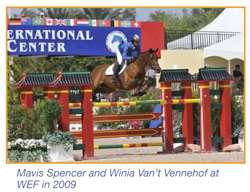 AM: Which horses are you riding? Do you have a favorite type of horse?
AM: Which horses are you riding? Do you have a favorite type of horse? 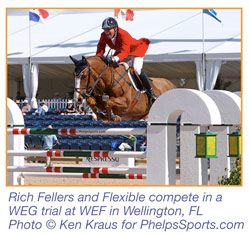
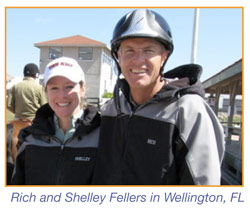 EqSol: What other horses will go to Europe?
EqSol: What other horses will go to Europe? 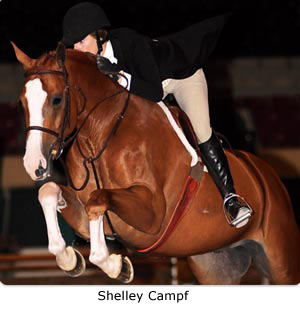 EqSol: So you made the horse business your real job?
EqSol: So you made the horse business your real job?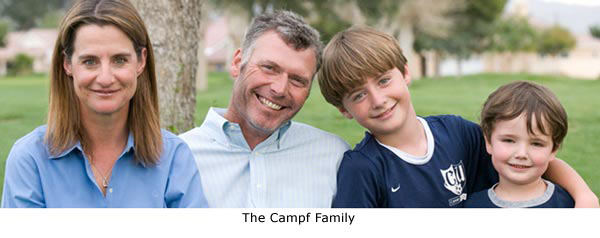 And yes, I also love to cook. I have to say that kickboxing fixed my neck – punch, punch left-right… and maybe helped me get some energy out.
And yes, I also love to cook. I have to say that kickboxing fixed my neck – punch, punch left-right… and maybe helped me get some energy out. Now tasting the sweetness of success with their first year horse, Small Affair, owners Liz Reilly and Chris Iwasaki are riding high. Small Affair and John French made a strong statement at Indoors this season, earning the Reserve Championship honors at both Harrisburg and Washington. The collective team also won two prestigious World Champion Hunter Rider Awards at Capital Challenge – the Jeffry Katz Award and the Rox Dene Award. The first is actually awarded to the rider of the WCHR high score horse who, in this case, was the phenomenal John French. And the second award, established in the name of the famous hunter Rox Dene, is awarded annually to the owners of the WCHR high score horse.
Now tasting the sweetness of success with their first year horse, Small Affair, owners Liz Reilly and Chris Iwasaki are riding high. Small Affair and John French made a strong statement at Indoors this season, earning the Reserve Championship honors at both Harrisburg and Washington. The collective team also won two prestigious World Champion Hunter Rider Awards at Capital Challenge – the Jeffry Katz Award and the Rox Dene Award. The first is actually awarded to the rider of the WCHR high score horse who, in this case, was the phenomenal John French. And the second award, established in the name of the famous hunter Rox Dene, is awarded annually to the owners of the WCHR high score horse.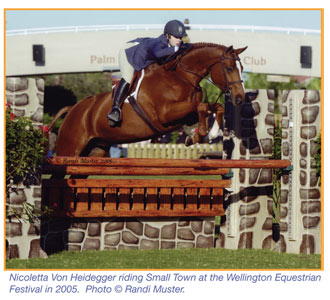 We also get really attached to each horse, so it’s actually a bit difficult to lease or sell one and have it leave home. I adore Small Town. I feel so lucky that he got leased to Sovereign Place, as they have been absolutely wonderful with him. They have really allowed me to remain involved and be part of all his huge successes.
We also get really attached to each horse, so it’s actually a bit difficult to lease or sell one and have it leave home. I adore Small Town. I feel so lucky that he got leased to Sovereign Place, as they have been absolutely wonderful with him. They have really allowed me to remain involved and be part of all his huge successes. Small Affair – Mary Morrison (Ivy Gate Farm) imported ‘Poker’ from France where he was successful in the young jumper championships. I originally saw him when looking at horses with Jim but he was way too green for his client. Then Scott and I went to try him last year. His form over the first little jump was the best I’d ever seen. When we got in the car, Scott, who is usually mister talkative, wasn’t saying a word. Finally he said ‘If you don’t vet him I will have someone else in the barn vet him.’ In 2008 he did the pre-greens as a six year old with Alissa Smith and Keri Kampsen and only won a few ribbons here and there. He was young and all over the place. We asked both John French and Jenny Karazissis to show him this year in the first years. He was champion or reserve almost every time, and won a class at Devon. He’s won a class at every major show he’s competed in, and often wins the under saddle. Next year is his Hunter Derby year, plus I’m going to start showing him.
Small Affair – Mary Morrison (Ivy Gate Farm) imported ‘Poker’ from France where he was successful in the young jumper championships. I originally saw him when looking at horses with Jim but he was way too green for his client. Then Scott and I went to try him last year. His form over the first little jump was the best I’d ever seen. When we got in the car, Scott, who is usually mister talkative, wasn’t saying a word. Finally he said ‘If you don’t vet him I will have someone else in the barn vet him.’ In 2008 he did the pre-greens as a six year old with Alissa Smith and Keri Kampsen and only won a few ribbons here and there. He was young and all over the place. We asked both John French and Jenny Karazissis to show him this year in the first years. He was champion or reserve almost every time, and won a class at Devon. He’s won a class at every major show he’s competed in, and often wins the under saddle. Next year is his Hunter Derby year, plus I’m going to start showing him.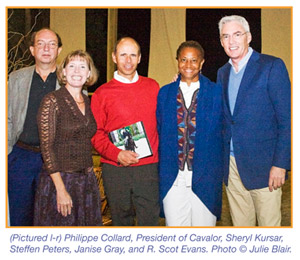 “When we started the foundation 15 years ago, we wanted to support our fellow horsemen,” said R. Scot Evans, President of the EAF and well known judge, clinician and consultant to the equine industry. “At that point, HIV/AIDS was considered the most threatening because the symptoms are so debilitating and the medical insurance is so expensive.”
“When we started the foundation 15 years ago, we wanted to support our fellow horsemen,” said R. Scot Evans, President of the EAF and well known judge, clinician and consultant to the equine industry. “At that point, HIV/AIDS was considered the most threatening because the symptoms are so debilitating and the medical insurance is so expensive.”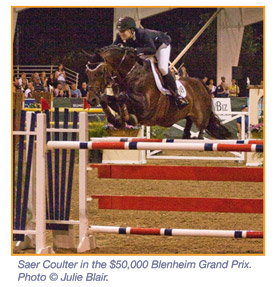 Saer is now in her final junior year – how time flies – and as most juniors do, she has set many goals. The hard work, focus and commitment have paid off, as those goals are one by one coming to fruition. When we spoke with Saer at Blenheim in June, she was fresh off winning in the Junior Hunters on the naturally talented Positano. Not to mention her fabulous third place finish in her fifth grand prix start at the 2009 Del Mar National followed by a seventh place finish at the Memorial Day Classic Grand Prix on Cats Are Grey. And based on her results at this June show she was hoping to attain her goal of qualifying for the NAYJRC, which she did. Before competing there at the end of July, she spent several weeks in the Netherlands, gaining invaluable European experience.
Saer is now in her final junior year – how time flies – and as most juniors do, she has set many goals. The hard work, focus and commitment have paid off, as those goals are one by one coming to fruition. When we spoke with Saer at Blenheim in June, she was fresh off winning in the Junior Hunters on the naturally talented Positano. Not to mention her fabulous third place finish in her fifth grand prix start at the 2009 Del Mar National followed by a seventh place finish at the Memorial Day Classic Grand Prix on Cats Are Grey. And based on her results at this June show she was hoping to attain her goal of qualifying for the NAYJRC, which she did. Before competing there at the end of July, she spent several weeks in the Netherlands, gaining invaluable European experience.